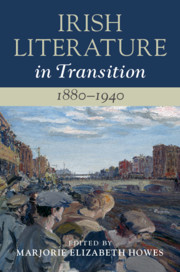Book contents
- Irish Literature in Transition, 1880–1940
- Irish Literature In Transition
- Irish Literature in Transition, 1880–1940
- Copyright page
- Contents
- Contributors
- Series Preface
- General Acknowledgements
- Chapter 1 Introduction
- Part I Revisionary Foundations
- Part II Revolutionary Forms
- Part III Major Figures in Transition
- Part IV Aftermaths and Outcomes
- Chapter 15 Re-imagining Realism in Post-Independence Irish Writing
- Chapter 16 The Free State of Poetry
- Chapter 17 Live Wires and Dead Noise: Revolutionary Communications
- Chapter 18 The Dead, the Undead, and the Half-Alive: The Transition from Narrative Plot to Formal Trope in Late Modern Irish Writing
- Part V Frameworks in Transition
- Index
Chapter 15 - Re-imagining Realism in Post-Independence Irish Writing
from Part IV - Aftermaths and Outcomes
Published online by Cambridge University Press: 28 February 2020
- Irish Literature in Transition, 1880–1940
- Irish Literature In Transition
- Irish Literature in Transition, 1880–1940
- Copyright page
- Contents
- Contributors
- Series Preface
- General Acknowledgements
- Chapter 1 Introduction
- Part I Revisionary Foundations
- Part II Revolutionary Forms
- Part III Major Figures in Transition
- Part IV Aftermaths and Outcomes
- Chapter 15 Re-imagining Realism in Post-Independence Irish Writing
- Chapter 16 The Free State of Poetry
- Chapter 17 Live Wires and Dead Noise: Revolutionary Communications
- Chapter 18 The Dead, the Undead, and the Half-Alive: The Transition from Narrative Plot to Formal Trope in Late Modern Irish Writing
- Part V Frameworks in Transition
- Index
Summary
Realism tends to be regarded within early twentieth-century Irish writing primarily as a vehicle for critiques of the Revival and associated visions of the Irish nation rather than for any significant literary contributions of its own. While realist writing does offer important counterpoints to the Revival, this narrow framing has effectively flattened the complexity of Irish realism in ways that conflate realism and naturalism and oversimplify the ideological functions of perspectives typically grouped under ‘the Counter-Revival’.
- Type
- Chapter
- Information
- Irish Literature in Transition, 1880–1940 , pp. 265 - 284Publisher: Cambridge University PressPrint publication year: 2020
- 2
- Cited by

